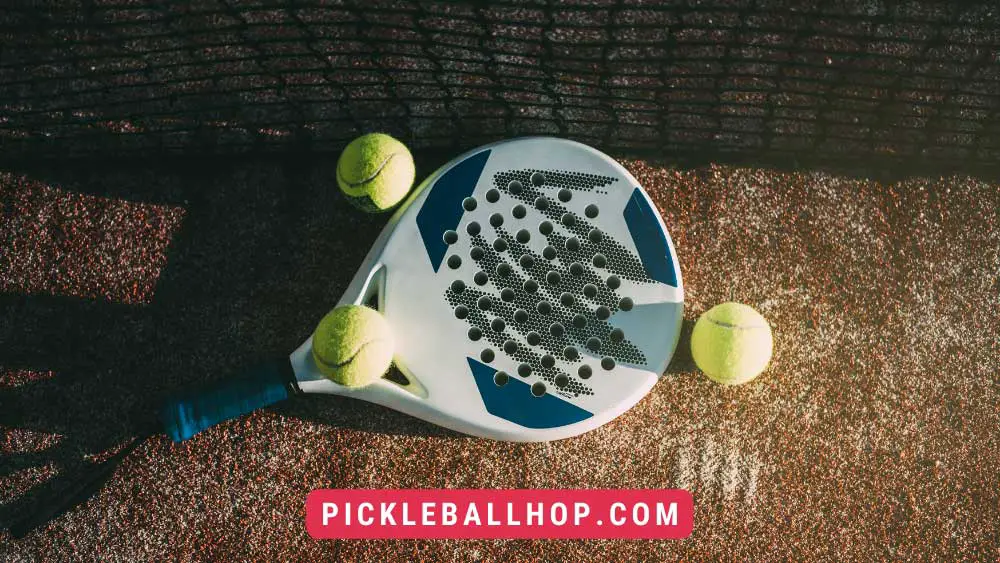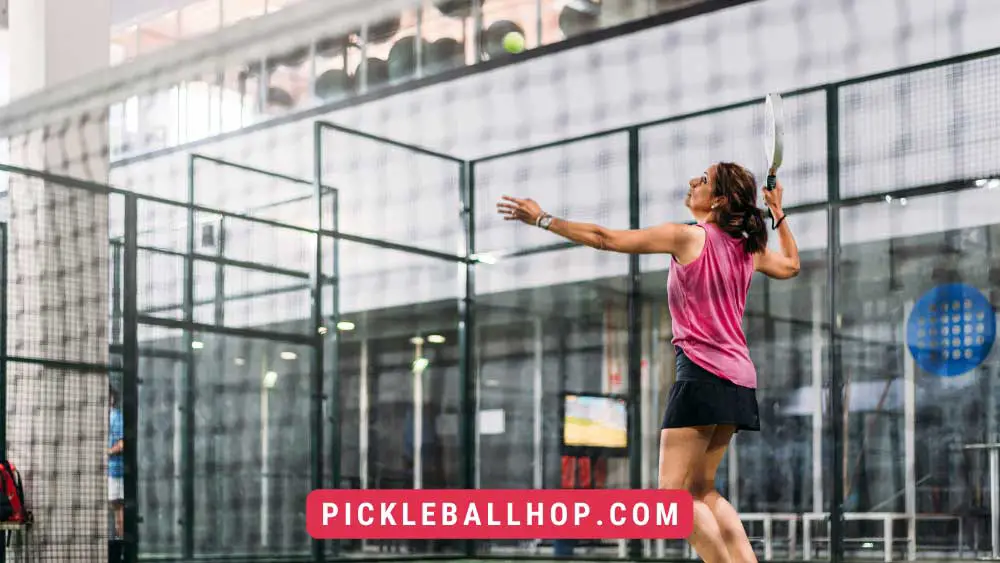Padel rules for 2023 are available in this guide. In padel, there are a number of specific rules that players must adhere to in order to ensure the game is played fairly and safely.
In this post, we will take a look at some of the most important rules in padel, so that you can be sure not to make any careless mistakes while playing!
Beginner’s guide to Padel rules & how to play

What is the fuss about padel tennis? Have you ever seen people playing it? This sport is played indoors on a walled court, similar to tennis. Beginners will enjoy its fast-paced nature.
These are some basic padel rules for beginners.
Scoring
Intervals and changes
Serving
Gameplay
Prerequisites – what do you need to play padel
- Padel courts are available for doubles and singles (20 x 10 m and 20 x 6 m, respectively). There are approximately 90% of Padel courts worldwide that are for doubles, as singles are rare. There are glass walls surrounding the back of the court, with mesh panels on the sides.
- Padel bats and rackets are both known as Padel Rackets. The stringless racket usually weighs between 300g and 400g and has a thickness of 38mm. It is made out of glass or carbon fiber.
- There are three Padel balls. Tennis balls look like Padel balls but their pressure is lower. A ball is never left on the ground when the ground is being used during rallies as it could cause interference.
- Four players. Played in its popular doubles format, two against two, pédala is a social activity.
You may enjoy reading Paddle Tennis vs. Padel
Objectives of the game
Padel is a game that anyone can play. You must miss the ball over the net into your opponent’s side in a way that will prevent them from returning it. The opposing team has the same goal as you: to prevent you from returning the ball to your side of the court.
It is essential for a player to understand how to take advantage of the ball’s bounce from the wall in padel since the court is enclosed and smaller than in other racket sports. This racket sport requires quick reaction times, a good sense of placement on the court, and the ability to read the game.
The official padel rules

Please find below our summaries of the official Padel Rules, as defined by the International Padel Federation (FIP).
Rule 1 – How to score in padel
Tennis and paddling have the same point system.
It will be called a “game” if the first point is a “15”, a “30”, a “40”, and a “30”. Each pair wins three points if they have won three, so a “deuce” is called. Should the same pair win the next point, the game is over. When a point is lost, the score goes back to “deuce”. Two consecutive points must be won by one pair of players to win the round.
In order to win a set, the pair that wins six games with a minimum margin of two will be deemed the winner. To win by seven, players must play two more games if they are tied after five games. The tie-break rule will be used in the event of a tie after six games.
Three sets make up the match. Two of the three sets must be won for the match to be won.
You may enjoy reading what are the 5 rules of pickleball?
Alternate scoring – The Golden Point
Padel has recently adopted the new rule of “No advantage” (golden point). It goes as follows:
- No point “Love”
- First point “15”
- Second point “30”
- Third point “40”
- Fourth point “Game”
When a match has three points each for both pairs of players, a “deuce” is called, and a deciding “golden point” is played. Service may be received on either the right or left side of the court depending on the receiving pair. However, when it comes to the deciding point, the receiving pair cannot switch positions. If one pair wins, the other pair loses.
Tie-break
“Zero”, “1”, “2”, “3”, etc. are the tie-break points.
If the players are tied after two sets, then the game and set will be decided by the first player to win seven points. After winning seven points, the tie-break continues.
In accordance with the set order, the player who serves first will initiate the “tie break”. One serve can be made from the right side of the court by this player. Following the previous order of service and serving from the left, the opposite team will serve the next two points. As each player serves two points consecutively, the order of service is always respected.
We will win the tie-break set 7-6.
During the tie-break, the player who failed to begin serving will start the following set.
Rule 2 – Game intervals
A “walkover” (WO) loss is awarded when a player fails to turn up 10 minutes after the game has started.
There will be a five-minute warm-up between the players.
The match should be played continuously from the start to the end, starting with the first service and ending with the last service. A match should not be suspended or delayed while a player recovers, receives instructions, or receives advice.
The maximum amount of time between points is twenty (20).
A maximum of 90 seconds will be allowed for changing sides. When a set ends in a tie-break, there will be no rest period.
During each set of eight exercises, the rest should last a maximum of one hundred twenty (120) seconds.
A point is considered to rest time once the previous one ends and the next point is served.
It is possible that players may be allowed an additional period of time (within reason) to replace their clothing, shoes, or equipment in the event of unforeseen circumstances.
“Tie breaks” allow players to change sides after 20 seconds.
You may enjoy reading Pickleball Kitchen Rules
In case of suspension
Whenever it’s raining, there’s insufficient light, there’s an accident, etc., a match is suspended, and the players have the option to warm up if they agree to:
- Up to five minutes of suspension. No warm up.
- Five to twenty minutes of suspension. Then a three-minute warmup.
- More than 20 minutes of suspension. Five minutes of warm-up.
From the point where the match ended before it was suspended, play will continue.
In case of accidental and medical conditions
An injured player is given a 3-minute break for treatment whenever he or she suffers a treatable medical condition. The player is allowed to receive medical attention for the aforementioned three minutes during the change of sides, and he can repeat the process during the following two changes.
A player can only receive medical care at one time, not their companion.
An athlete suffering an injury that is not directly related to the game but is indirectly caused by the game may receive 15 minutes of treatment from the tournament umpire.
A player cannot continue to play if he has bleeding wounds.
Rule 3 – Positions of players in padel
On the court, each pair of players will be on either side of the net. The serve is made by a player serving the ball, and the ball is then received by a player diagonally in front of him or her.
It is possible for a receiving player and his or her partner, as well as the server, to be anywhere on his or her side of the court.
Rule 4 – Choice of server and ends
Flipping a coin will determine which side and which order of service will be served. Options include:
- Serving or receiving first. If neither pair selects a side, they will serve.
- The first game was played on this side of the court. Other players had the option of serving or receiving.
- Let the opponents make their choice first.
Both pairs must tell the umpire who will serve first and who will receive first when the order of serve and ends (sides) is determined.
Rule 5 – Changing ends
After the first, third, and every even-numbered game in a set, the players have to switch sides.
The players alternate sides every six points during the tiebreak.
It is imperative to correct an error immediately upon discovery if the players do not change ends (sides). Whenever an error was apparent before a point was won, it is still valid.
Rule 6 – Padel serve
The service is the starting point for all points. Should the first service be invalid, a second service can be used. To do so, follow these steps:
Once the player serving begins the service, he or she must maintain this position, with both feet on either side of the service line, between the central line of service and the sidewall (where the service box is positioned), until the ball is served.
As the server is placed in the service box where they are positioned, they must bounce the ball on the ground in order to serve.
Servers may not touch the service line with their feet or the imaginary central line.
The player must stand with at least one foot on the ground and swing the ball at or below waist level when hitting the ball.
The server serves the ball on the right side of the court, and it crosses over the net diagonally towards the receiver’s box of service. When the ball bounces inside the box, it is a service. To start, the ball should be served into a box located on the left side of the receiving box, but if one side wins the point, the ball should be served into a box on the right side of the receiver, and so forth.
Walking, running, and jumping are forbidden while serving. Providing that foot movement does not negatively impact the position, light foot movements will be accepted.
A serve is considered to have been made as soon as a ball is struck, or attempts to hit it are made.
Players select who will serve first at the beginning of every set. Until the next set has begun, the order cannot be altered.
In order to serve, the server must wait for the player receiving to finish. The player will, however, be ready to accept the service as soon as it is made available after several days of adapting to the server’s rhythm.
you can also learn our guide about choosing a paddle here.
Rule 7 – Padel service fault
Faulty services include:
- Rules 6 or 7 are violated by the server
- The server misses the ball when he attempts to strike it.
- There is an outside bounce outside the receiver’s service box (the lines are good).
- The ball hits any object carried or worn by the server or his companion.
- It bounces in the receiver’s service box before hitting its second bounce and touching the metal fence surrounding the court.
Rule 8 – How to return a serve in padel
After the ball bounces within their receiving box of service, receivers must make sure the ball doesn’t hit the ground for a second time before hitting it.
A player who receives the first service of a set will continue to receive this service until the end of the set; this player’s service will be determined by the receiving player.
In the tie-break, or during the set, the order cannot be changed. It may, however, be changed at the beginning of a new set.
If the server’s ball hits the receiving player or their racket before it bounces, then the point goes to the server.
Rule 9 – Let service (net cord)
Typically, a service is defined as a “net” if:
- If the ball does not hit the metallic fence before its second bounce, the ball touches the net or the posts before arriving at the receiver’s service box.
- Once a ball hits a net or post (if they’re inside the playing area), it hits any player or item they’re carrying or wearing.
Repetition of service (let) occurs if:
- If the receiver is not ready to receive the ball, the ball is served.
- If the first serve is allowed, the server can serve two (2) times.
- On the second serve, the server can only repeat if the “net” or “let” appear
Rule 10 – Repetition or let point
The points in dispute are “let” if:
- A split ball occurs during play.
- It is possible for elements unrelated to the game to enter the court area.
- Unexpected circumstances that interrupt a match unrelated to the players.
- It is the player’s responsibility to inform the umpire immediately when he or she believes that a “let” situation has arisen. Continued play forfeits the right to a “let”.
- Umpires decide if the “let” is appropriate when the request is made. Players lose points if the “let” is inappropriate.
Rule 11 – Interference
The act of interfering with another player’s shot occurs when a player intentionally or involuntarily does so. In the event of deliberate interference, the Umpire will award the point to the opponent. A point will be repeated by the Umpire in an involuntary interference.
Rule 12 – Ball in play
The ball will be hit alternately by each pair of players.
As soon as a valid service is made, the ball remains in play until the score is determined or “let” is called.
It is imperative to return the ball before it bounces again after it has bounced in the opponent’s ground. If it hits any part of the court before it bounces again, it remains in play.
Courts consist of the inner walls of the building, the fence surrounding the building, the ground, the net, and the posts holding it up. All of these components are included in the fence.
Rule 13 – Losing padel points
Losing a point occurs when:
- In a game, either player, their rackets, or anything they are wearing and carrying has direct contact with the net, the posts, the tension cables, or any part of the opponent’s court.
- The ball bounces a second time before being returned.
- After getting bounced, the ball crosses the outer perimeter (laterally or through the gate) of the court.
- Playing off-court is authorized. Once the ball bounces in the proper direction, it crosses over the end wall and exits the court. In the event that the ball crosses the sidewall or passes through a door, the ball is deemed to have crossed the court if it bounces a second time or touches anything outside of the court.
- This applies when a player hits the ball before crossing the net.
- Whenever a player returns the ball, whether directly or by hitting it off their court’s walls, the ball hits the wall of the opponent’s court, the metallic fence, or anything else on the opponent’s court that isn’t part of the court’s ground.
- The ball hits the net, net posts, fence, or any element of the opponent’s court not directly related to or located on the opponent’s court if the ball is returned directly to their court or off the walls.
- Two balls were hit by the player. The player struck both balls.
- A ball could touch a player on the field, their partner, or anything they are wearing.
- A player or piece of equipment other than a racket is hit by the opposing team’s ball.
- The ball touches either the metallic fencing, any part of the court on the player’s side, or any other non-court element located on their side of the court.
- During the play of the point, the player leaps over the net.
- Players lose points if the ball is struck simultaneously or successively by both players. Players may only play the ball simultaneously.
- Any part of the body or foot of the player who hits the ball is outside of their court. Unless they are allowed to play outside.
- Two consecutive errors are served by a player.
You may enjoy reading Pickleball Line Call Rules
Rule 14 – The correct return
Generally, Returns are correct if:
- When the player hits the ball, it bounces directly into the opponent’s court or it strikes the wall on his own court before hitting the opponent’s wall.
- When the ball bounces on your opponent’s court, it hits one of their walls or metallic fences.
- When the ball touches the net or the net posts, it lands on the opponent’s court.
- The ball hits a non-court-related object on the ground of an opponent’s court (e.g., another ball).
- As long as the ball was not hit twice, the impact happened with the same movement, and the natural exit from the ball did not differ greatly, a “scooped” or “pushed” ball will be considered a correct return.
Rule 15 – Winning padel points
You win the point if:
- It is possible for the ball to bounce in the opponent’s court and then exit the court through a hole or become stuck there.
- When the ball bounces in the opponent’s court, it gets stuck on the horizontal surface of the wall.

Rule 16 – Out-of-court play authorized
Providing the court has a safety area, the players can play the ball outside the court if the court is suitable for such play.
Rule 17 – Changing the ball
It is the organizer’s responsibility to announce in advance:
- Ball-type and brand.
- The match will be played with two or three balls.
Ball change policy if there is one. You can change a ball using one of these methods for each match:
- The number of games is odd according to the established rule. A warm-up period and a tie break count as two games for the change of balls.
- A ball will not be changed at the start of a “tie break”. Due to the delay in the change of balls, the following set will begin after the second game.
- At the beginning of a set.
- A ball that has been lost, broken, or deteriorated substantially will be replaced by the Umpire with one of the same condition as the ones currently in play. A ball that is broken or lost must be replaced. It is recommended that two balls are available at the beginning. Also take a look at the below video:
Padel rules Faqs
What is Golden Point?
In competitions, Golden Points have been introduced as a new points system. A decisive point will be scored if the score is 40-40. Golden points are not required in amateur games.
In padel, can you hit the fence?
Always bounce the ball on the ground before hitting a fence or wall. Whenever a ball strikes a wall or fencing before it reaches the playing field, it loses a point.
Would you be able to play singles padel?
Singles padel can be played, but it is not very common. The number of single courts in the world is less than ten percent.
Is it possible to touch the net in padel?
It is not allowed for players to touch the net during play
In padel, can your racket be across the net?
If our rackets, bodies, or clothes are never allowed to touch the net or the net side.
Can padel be easier than tennis?
Tennis is more difficult to learn than padel. Padel players benefit from having a short-handed racket because it makes controlling the ball easier. Short-handed rackets are also easier to handle physically.
You may enjoy reading Singles Pickleball Rules
Final Thoughts
If you’re looking for a fun, new sport to try out, padel may be just the thing. This up-and-coming game is gaining popularity all over the world and is perfect for players of all levels. Whether you’re a beginner or an experienced player, padel offers something unique and exciting that you’ll love. So what are you waiting for? Grab your friends and get ready to hit the court!
You may enjoy reading Nude Pickleball Is Taking Off





